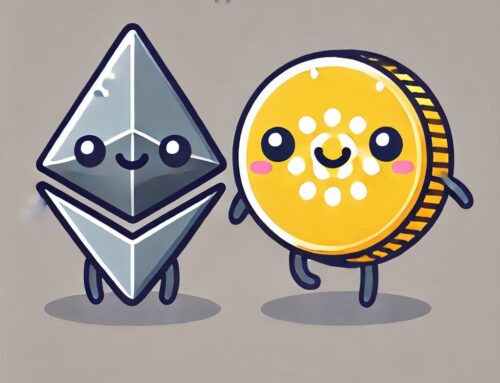Wallet Organization: Taming the Crypto Zoo – Because a Tangled Wallet is a Terrible Wallet!
Alright, crypto wranglers, gather around! Let’s have a heart-to-heart about Wallet Organization. No, we’re not talking about decluttering your physical wallet (though, let’s be honest, most of us could probably use some help there too). We’re talking about the often-overlooked but absolutely crucial art of managing multiple crypto wallets.
If you’re anything like most crypto enthusiasts, you’ve probably accumulated more wallets than you have socks (and that’s saying something!). And guess what? That’s perfectly okay! In fact, having multiple Cardano wallets, and knowing how to manage them effectively, is often recommended, and even essential, for optimal security and organization.
Think of it like having multiple bank accounts, each carefully designated for a specific purpose, rather than just throwing all your digital dough into one giant, chaotic pile. So, if you’re feeling like your crypto wallet organization is more of a digital dumpster fire than a well-oiled machine, fear not! Let’s dive into the best practices for managing different types of Cardano wallets, and how to use them effectively.
Why Bother with Multiple Wallets? (Because One Wallet to Rule Them All is a Terrible Idea!)
Before we get into the “how-to” of Wallet Organization, let’s quickly address the “why”. Why would you even need multiple Cardano wallets in the first place? Isn’t one wallet enough? Well, while simplicity is tempting, putting all your crypto eggs in one basket is generally not a wise move. Here’s why strategic Wallet Organization is so important:
-
Enhanced Security: Don’t Put All Your Eggs in One Digital Basket! Storing all your cryptocurrency in a single Cardano wallet can be a risky proposition. If that one wallet is compromised (through a hack, a phishing scam, or your cat deciding to take a bath in your laptop), you could lose everything. By using multiple Cardano wallets, you significantly reduce the risk of losing all your funds if one wallet happens to get compromised. It’s like not putting all your eggs in one basket – if one basket falls, you still have eggs in other baskets. This diversification is a cornerstone of good Wallet Organization.
-
Organization and Purpose: A Wallet for Every Occasion! Different Cardano wallets can be used for different purposes, streamlining your crypto life and making everything easier to manage. For example, you might use one wallet for daily spending, another for long-term storage (your “HODL” wallet), and yet another for interacting with specific decentralized applications (dApps). It’s like using different folders on your computer to organize your files, or having different drawers for different types of clothing, and makes Wallet Organization much more intuitive.
-
Privacy: Separating Your Digital Identities! By using multiple Cardano wallets, you can separate your transactions and maintain greater privacy. It’s like using different email accounts to separate personal and work correspondence, and prevents anyone from easily tracking all of your crypto activities. This privacy-focused approach to Wallet Organization can be very beneficial.
-
Testing New Features: A Sandbox for Your Crypto Experiments! You can use a separate Cardano wallet to test out new features, explore new decentralized applications (dApps), or experiment with risky DeFi strategies, without putting your main funds at risk. It’s like having a digital sandbox, where you can experiment with different things before deploying your projects to the main network. This risk-management strategy is a smart aspect of Wallet Organization.
-
Different Cryptocurrencies: Keeping Your Crypto Kingdom in Order! If you hold multiple cryptocurrencies (beyond just ADA), using separate wallets for each can help keep your assets organized, and prevent confusion. It’s like having different drawers to store different types of clothing, or using different bank accounts for different currencies. Effective Wallet Organization becomes even more crucial when you manage multiple types of digital assets.
Types of Wallets and Their Uses: A Quick Tour of the Crypto Wallet Landscape
Before we dive into the nitty-gritty of Wallet Organization, let’s do a quick recap of the different types of Cardano wallets available, and what they are best suited for. Understanding the different types of wallets is the first step in effective Wallet Organization.
-
Software Wallets (Hot Wallets): Speedy and Convenient, But Keep an Eye on the Temperature! These are applications installed on your computer or mobile device, offering easy access and quick transactions. Examples include Eternl, Lace, Yoroi, and Daedalus (in its light wallet mode).
-
Convenient and Easy to Use: Software wallets are great for everyday transactions, quick access to your funds, and general ease of use, making them ideal for regular Cardano users.
-
Online Vulnerabilities: Being connected to the internet, software wallets are more susceptible to online threats and malware, and should not be used for storing large amounts of crypto.
-
-
Hardware Wallets (Cold Wallets): The Fort Knox of Crypto Security! These are physical devices designed to store your private keys offline, providing the highest level of security. Examples include Ledger and Trezor.
-
Enhanced Security: Hardware wallets provide the highest level of security for long-term storage, and are highly recommended for anyone holding a significant amount of crypto.
-
Less Convenient for Daily Use: Hardware wallets are not as practical for frequent, everyday transactions, as they require a physical device to be connected every time you want to make a transaction.
-
-
Exchange Wallets: Trading Hubs, Not Long-Term Storage! These are wallets provided by cryptocurrency exchanges where you buy, sell, and trade cryptocurrencies. Examples include wallets on Binance, Coinbase, Kraken, etc.
-
Convenient for Trading: Exchange wallets are great for quick trading and exchanges between different cryptocurrencies, as they are designed to be used on trading platforms.
-
Risk of Exchange Hacks: Exchange wallets are custodial, meaning that the exchange controls the private keys, and are therefore vulnerable to exchange hacks or potential platform issues, and should not be used for long-term storage.
-
-
Paper Wallets: The Old-School Approach (Proceed with Caution!) These are paper documents with your private and public keys printed on them, offering a very low-tech (but surprisingly secure) storage method.
-
Extremely Secure (In Theory): Paper wallets can be extremely secure for long-term storage, if generated correctly, and if the paper is physically protected from damage, but are not generally recommended for most users.
-
Not Convenient for Daily Use (Highly Impractical!): Paper wallets are incredibly inconvenient to use and access when transacting, and are not suitable for everyday use, or for anyone who wants to actively use their crypto.
-
Best Practices for Mastering Wallet Organization: Your Step-by-Step Guide to Crypto Sanity
Now, let’s get down to the practicalities: mastering Wallet Organization and bringing order to your crypto kingdom! Here’s a step-by-step guide to help you get organized and secure:
-
Categorize Your Wallets: Define a Clear Purpose for Each! The first step in effective Wallet Organization is to categorize your wallets, and decide what each wallet will be used for. For example:
-
Spending Wallet (Hot Wallet): A lightweight software wallet like Eternl or Lace for everyday transactions, and smaller amounts of crypto that you are actively using.
-
Savings Wallet (Cold Storage): A hardware wallet for long-term storage of the majority of your ADA and other valuable cryptocurrencies, and keeping them safe and secure.
-
Trading Wallet (Exchange Wallet): An exchange wallet for quick trades and conversions, keeping only the funds that you are actively trading on the exchange platform.
-
Testing Wallet (Sandbox Wallet): A separate software wallet for trying out new features, experimenting with dApps, or testing new strategies, without putting your main funds at risk.
-
-
Use Strong Passwords: The First Line of Defense! Use strong and unique passwords for all your wallets, and never, ever reuse passwords for different services, as password reuse is a major security risk.
-
Secure Your Recovery Phrases: Treat Them Like Gold! Protect your recovery phrases (or seed phrases) for all your Cardano wallets. Store them offline, in multiple secure locations (think safe deposit boxes, fireproof safes, or buried treasure chests – okay, maybe not buried treasure chests), and never share them with anyone, no matter how trustworthy they seem. It’s like creating a secure treasure map that only you can read, and storing it safely away from prying eyes.
-
Keep Software Updated: Stay Ahead of the Bad Guys! Always use the latest version of your software wallets (Eternl, Lace, Yoroi, Daedalus) to ensure they are protected against the latest vulnerabilities. Software updates often include crucial security patches, so keeping your software up to date is essential for good Wallet Organization.
-
Integrate Hardware Wallets: The Ultimate Security Upgrade! Use hardware wallets to secure your long-term storage wallets, and connect them to your software wallets (like Eternl or Yoroi) for secure and convenient management. It’s like having a state-of-the-art security system that’s controlled remotely, so you can access your funds whenever needed, but they are still protected by a hardware device.
-
Regular Backups: Don’t Let Your Crypto Vanish! Regularly backup your software wallets, and make sure that your recovery phrases are always up to date, and safely stored.
-
Use Separate Devices (If Possible): Create a Dedicated Crypto Zone! If possible, use separate devices for different types of Cardano wallets. For example, use a dedicated computer for your trading wallet and your hardware wallets, and a separate mobile device for your spending wallet. This further isolates your wallets and reduces the risk of cross-contamination.
-
Keep a Record: Your Crypto Inventory! Keep a detailed record of all your Cardano wallets, including wallet names, addresses, the purpose of each wallet, and where you’ve stored your recovery phrases. It’s like having a digital map of your financial landscape, so you always know where everything is.
-
Regular Audits: Check Your Crypto Checkbook! Perform regular audits of your Cardano wallets, checking that all your transactions are accurate, and all your balances match what you expect. This helps you catch any unauthorized transactions early on.
-
Be Aware of Scams: Stay Vigilant, Stay Safe! Be constantly cautious of phishing scams, and always double-check website addresses, and application sources before entering any sensitive information. Scammers are always lurking, so vigilance is key to good Wallet Organization.
-
Stay Organized: Crypto Zen! Ultimately, effective Wallet Organization is about staying organized and keeping track of all your digital assets in a systematic way. A little organization goes a long way in the world of crypto!
The Takeaway: Wallet Organization – Your Path to Crypto Peace of Mind
Mastering Wallet Organization might seem like a daunting task at first, but it’s an absolutely essential part of keeping your cryptocurrency safe and secure. By categorizing your Cardano wallets, using strong security practices, and diligently protecting your recovery phrases, you can effectively manage your digital assets with confidence, and enjoy a more organized and stress-free crypto life. It’s not just about having a wallet; it’s about building a robust and well-organized system that protects all your funds and investments, and allows you to navigate the world of crypto with peace of mind.





